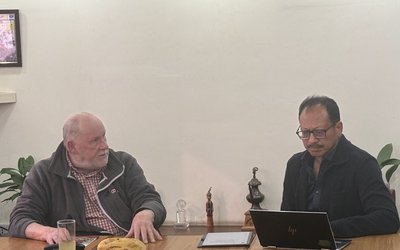
How do you view the state of natural disasters in Nepal?
There has been an increase in the number of natural disasters over the past few years and Nepal has been incurring huge losses annually. Nepal is one of the most disaster prone countries in the world and studies have already shown that climate change will intensify the disaster related incidents in the days to come. For instance, between the period of 1971-2007, there were casualties accounting for over 27,000 lives, 50,000 injuries and 3,000 missing. More than 5 million people were affected by the disasters.
How do look at the responses?
Although the Disaster Risk Reduction (DRR) is very much interrelated with climate change, disaster related issues are yet to get the priority like that of climate change. Due to high priority given to climate change, institutional mechanisms are in place to look at the climate change issue. There is a Climate Change Council under the chairmanship of prime minister and the Ministry of Science, Technology and Environment is coordinating various institutions. However, disaster issues are yet to get similar priority and institutional back up. Although Disaster Risk Reduction agenda is has a link with climate change, there is a breakup of the programs in the context of implementation.
Why do climate change and DRR need to be linked up?
As Disaster Risk Reduction (DRR) and climate change is interrelated, they need to be taken up together. How can you separate them?
How do you see the present setup in terms of the DRR?
Of course, there is a high level institutional mechanism headed by the Minister of Home Affairs and the Home Ministry is responsible to coordinates the disaster related issues. Yet, disaster is still to get a high priority. Under the existing law, there are several committees at different l levels under the Ministry of Home to coordinate with the Disaster Risk Reduction issue; there is always a gap in coordination at the policy level as well as at the ministerial level. In this context, the need is there for a multi-stake holder national coordination mechanism. The earthquake of 2011 taught us a lesson that there is a lack of an institutional capacity and capacity to respond to major earthquakes and other natural calamities. Most policies and plans are focused on post disaster activities. Since the basic priority of the Ministry of Home Affairs is to maintain law and order, it focuses its attention and resources on the law and order.
How do you see the level of resources?
I don't think resource is a problem any more in the area of Disaster Risk Management and Disaster Risk Reduction. Along with the government’s annual budget, Nepal’s development partners have also been spending resources in the sector.
How do you see the expenditure pattern?
One of the challenges is to use the available resources properly. The resources must be spent in a result oriented manner. Despite spending resources in eastern Nepal, we have been unable to restore schools and other infrastructure and provide relief to the people. It is unfortunate that we have yet to map district level resources and equipment. This is happening because of the lack of institutions to coordinate at the policy level.
What role can institutions like the National Planning Commission play in DRR?
As the planning advisory body of the government, NPC has been actively promoting ideas to mainstream DRR into development activities through its periodic development plans. Along with other sectors, NPC has a mandate to approve annual plans and programs, including on disaster related issues before their implementation.
How do you look at disaster from the development perspective?
As disaster has been creating havoc in the development sector by destroying property worth of millions of rupees, the time has come now to look at disasters from a development perspective as well. Although disaster management is not generally associated with plan and financing, there are in fact a number of schemes in operation, such as for drought proofing, aforestation, drinking water, etc, which deal with the prevention and mitigation of the impact of natural disasters. This is the reason NPC has been actively promoting mainstreaming DRR into development activities through its periodic development plans. The tenth five development plan, Interim Plan 2007-2010 and 2010-2013 also incorporated DRM and DRR to deal with disasters.
What is NPC doing now?
As the National Planning Commission is not in the process of formulating the three years plan. We are trying to include the issues relating to the management and mitigation of natural disaster more explicitly in coming three years plan. Our experiences have shown that the impact of major disasters cannot be mitigated by the provision of immediate relief plan only. Our Disaster Risk Management is heavily influenced by calamity relief. Disaster is beyond that. Last year’s earthquake in the eastern part of Nepal taught us many lessons. For instance, we are yet to build the schools, buildings and other infrastructure damaged by the quake. It showed that we need to be sensitive towards disaster prevention and mitigation aspects. As they also directly hit the development sector, disasters need to be looked at from the development perspective.
How do you see the state of coordination?
Given our past experiences, there is a growing realization about the need to have a strong mechanism to coordinate the inter ministries to implement the DRR and CRM.
As long as the existing act remains, one cannot change the mechanism. How do you look at this?
Although the government has already tabled the new Natural Disaster Bill in the parliament to deal with the disaster issue in the broader perspective, it is now stalled due to the dissolution of the parliament. The existing Natural Calamity Act is in the process of replacement. The new bill for the first time proposed a central level Disaster Management Authority to look at the issue in broader perspective. I don’t think it will alone fulfill the required institution to bridge the existing gap at the policy level. The roles of National Planning Commission will still there is policy harmonization and coordination.
What are the lapses now?
There is a visible disconnect between different sector’s policies and plans. The challenges include the lack of comprehensive plan backed by strong policies and plans. There is an absence of a multi stake-holder national coordination mechanism, lack of dedicated resources, absence of continuous risk assessment and monitoring process, multi-hazard early warning system and institutional capacity in DRR including the capacity to respond to major earthquake and other disasters. One of the major challenges before us is to mainstream Disaster Risk Management and Climate Risk Management in National Development Planning Process. We have already conducted a few programs to look at the role of various ministries.
What level of coordination is working now?
There are adequate resources allocated by the government and international donor communities and INGOs. What is lacking is the policy level coordination. The present Disaster Relief Act just talks about the local level coordination during the time of disaster but it does not envisage the body for policy level coordination.

Purushotam Ghimire
Mr. Ghimire, Former Joint Secretary, Expert/Resource person of CC, DRR, SDGs, participates in the climate discussion at the national and international level. He could be contacted via his email: purughimire@yahoo.com, or gihimirep@gmail.com
- Opportunities For Synergistic Climate Response
- Oct 27, 2017
- Disaster Risk Reduction: Words And Actions
- Nov 22, 2014
- Mainstreaming Disaster In National Development
- Sep 26, 2014
- Managing Disaster Risk And Climate Change
- Sep 11, 2014
- Impact Of Disasters In Nepal
- Aug 29, 2014















